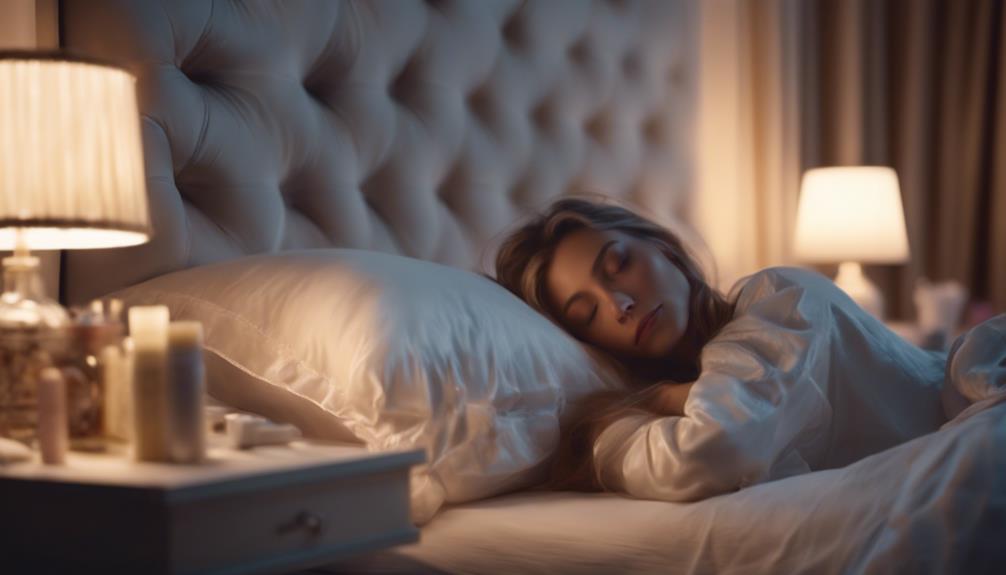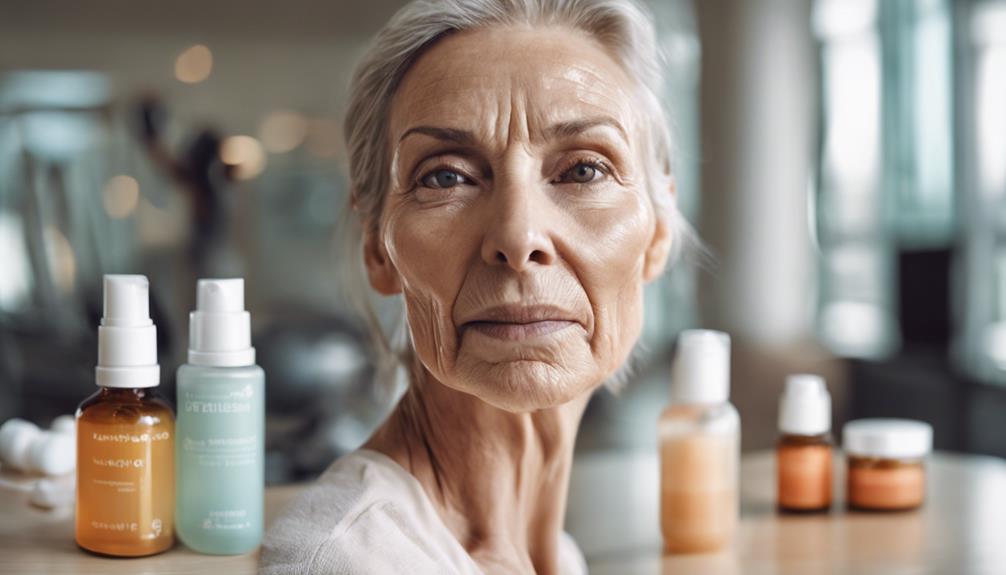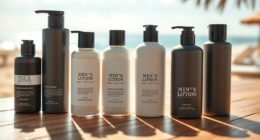Your pillowcase could be sabotaging your beauty sleep. If you're using cotton, it absorbs moisture, dries out your skin, and can even strip away skincare products' effectiveness. The rough texture may lead to sleep lines and wrinkles. In contrast, silk pillowcases keep moisture in and reduce friction, promoting smoother skin and healthier hair. Dirty pillowcases only complicate things further by harboring bacteria and oils, which can cause breakouts. By switching to silk and maintaining cleanliness, you could enhance your nightly beauty routine greatly. Stick around for tips on how to choose the best pillowcase for your beauty sleep.
Key Takeaways
- Cotton pillowcases absorb moisture and can strip away beneficial skincare products, leading to dry and flaky skin.
- The rough texture of cotton can cause friction, resulting in sleep lines and premature wrinkles.
- Dirty pillowcases accumulate dirt and bacteria, increasing the risk of breakouts and skin irritations.
- Silk pillowcases help retain moisture and reduce friction, promoting healthier skin and minimizing wrinkles.
The Pillowcase Conspiracy
You may not realize it, but your cotton pillowcase could be sabotaging your skincare routine every night. Cotton is highly absorbent, which means it's likely soaking up the very moisture you're trying to keep on your skin. When you apply your favorite moisturizer before bed, that cotton pillowcase can draw away essential hydration, leaving your skin dry and flaky by morning. This constant moisture loss can also lead to irritation, making your skincare efforts feel futile.
Moreover, if you're not washing your cotton pillowcase regularly, you're allowing dirt, face oils, and bacteria to accumulate on its surface. This buildup can clog your pores and trigger breakouts, further complicating your skincare routine. Instead of waking up with a glowing complexion, you might find yourself battling new blemishes and persistent dryness.
Switching to a silk or other innovative fabric pillowcase can be a game-changer. These materials don't absorb moisture, helping to maintain your skin's hydration levels and promote healthier, clearer skin.
Prioritize your beauty sleep by reconsidering the fabric you rest your head on every night. Your skincare deserves it!
How Fabrics Affect Your Skin

When it comes to pillowcases, the fabric you choose can greatly impact your skin's health.
Cotton might absorb your skincare products and cause dryness, while silk helps retain moisture and reduces wrinkles.
Plus, your sleep position plays a role in how these fabrics affect your skin, so it's worth considering all these factors for a better night's rest.
Cotton Vs. Silk Benefits
Cotton and silk pillowcases each offer distinct benefits that can greatly impact skin health and appearance during sleep. If you're aiming for healthy skin, the choice of pillowcase fabric matters more than you might think.
Cotton Pillowcase: Highly absorbent, it can draw moisture away from your skin, leading to dryness and irritation. The friction from cotton may also cause sleep lines and skin creases.
Silk Pillowcase: Retaining moisture, it helps keep your skin hydrated, reducing the appearance of fine lines and wrinkles. Its smooth surface minimizes friction, which means fewer skin issues.
Cleanliness: Cotton can trap dirt, oils, and bacteria, potentially worsening acne. On the other hand, silk promotes a cleaner sleeping environment, enhancing the effectiveness of your skincare products.
Pillowcase Maintenance Importance
Maintaining clean pillowcases is vital for skin health, as the fabric choice and its upkeep can greatly influence how your skin feels and looks overnight. If you're using cotton pillowcases, they can absorb moisture and your skincare products, leaving your skin drier by morning.
Dirty pillowcases can also harbor bacteria and allergens that may trigger acne or worsen skin irritations, making regular washing imperative.
Additionally, the texture of your pillowcase plays a significant role in your skin's condition. Rough fabrics can create friction, leading to sleep lines and wrinkles. In contrast, smooth materials like silk can help minimize this risk, allowing you to wake up with a more refreshed complexion.
To keep your skin looking its best, you should wash your pillowcases at least once a week. This frequency not only guarantees a clean sleep environment but also helps retain the benefits of your skincare products.
Sleep Position Effects
Your choice of pillowcase fabric can greatly influence how your skin reacts during sleep, especially based on your sleeping position. If you're sleeping on your side, the rough texture of cotton pillowcases can exacerbate the formation of fine lines and deepen facial wrinkles. This friction pulls at your skin, making it more susceptible to damage over time.
Consider these effects based on your sleep position:
- Side Sleepers: Increased friction can lead to deeper sleep lines and accelerated aging.
- Back Sleepers: Less friction helps to maintain collagen, reducing wrinkle formation.
The right fabric can markedly improve your skin's health while you sleep. Opting for silk or satin pillowcases can minimize the wear and tear on your skin, keeping those fine lines at bay.
Signs of Pillowcase Betrayal

If you're waking up with dry skin or unexpected breakouts, it might be time to investigate the betrayal of your pillowcase. Your cotton pillowcase could be the culprit, soaking up all the moisture from your skin overnight. This high absorbency not only leaves your skin thirsty but can also lead to dry, flaky patches that no amount of moisturizer can fix.
Additionally, if you notice an increase in acne or breakouts, take a closer look at your pillowcase. Accumulated dirt and oils can clog your pores, creating an environment ripe for irritation. Plus, dust and allergens trapped in cotton fibers can exacerbate skin issues, leading to compromised skin health.
You mightn't realize it, but your pillowcase could be sabotaging your skincare routine. When it absorbs your serums and creams, it reduces their effectiveness, wasting your efforts.
If you've been experiencing these signs of pillowcase betrayal, it may be time to contemplate a switch. A better pillowcase can make a world of difference for your skin's health and appearance.
The Beauty Benefits of Silk

Switching to silk pillowcases can do wonders for your beauty routine.
Their non-absorbent nature helps keep your skincare products working overnight, while the smooth surface reduces friction, cutting down on sleep wrinkles.
You'll not only wake up with healthier skin but also notice an improvement in your hair's texture, making silk a game-changer for your beauty sleep.
Non-absorbent Silk Benefits
Silk pillowcases provide numerous beauty benefits by preserving the potency of your skincare products while you sleep. Thanks to their nonabsorbent nature, these luxurious cases guarantee that your serums and moisturizers stay on your skin rather than getting absorbed into the fabric. This means you wake up with hydrated, glowing skin instead of dry patches.
Here are three key benefits of using silk pillowcases for your skin care routine:
- Moisture Retention: Silk helps retain moisture, preventing your skin from drying out overnight.
- Enhanced Product Efficacy: By keeping your skincare products on your skin, silk allows them to work effectively while you sleep.
Switching to a silk pillowcase is a simple, yet effective way to elevate your beauty routine. You'll not only enjoy the feel of silk against your skin but also reap the benefits of improved hydration and skincare efficacy. Your skin will thank you every morning!
Reduced Friction and Wrinkles
Using a silk pillowcase not only enhances your skincare routine but also greatly reduces friction, helping to prevent the formation of wrinkles and sleep lines. The smooth surface of silk creates a barrier that minimizes the contact between your skin and the pillow, reducing friction that can cause creases over time. This means you can wake up with fresher, more youthful-looking skin after a night of beauty sleep.
Moreover, silk's nonabsorbent nature helps maintain your skin's moisture, further preventing dryness and irritation that may lead to premature aging. When your skin stays hydrated, it appears plumper and healthier, reducing the likelihood of fine lines.
Studies have shown that regular use of silk pillowcases can lead to noticeable improvements in skin texture and overall appearance. Not only do these pillowcases benefit your skin, but they also contribute to healthier hair by preventing breakage and frizz.
Enhancing Your Sleep Routine

Upgrading to a silk pillowcase can transform your sleep routine by locking in moisture and promoting healthier skin and hair overnight. Unlike traditional cotton, silk helps prevent dryness, ensuring you wake up looking refreshed.
To further enhance your nighttime experience, consider these tips for better sleep:
- Wash your pillowcases at least once a week to minimize bacteria buildup, which can disrupt your sleep and cause skin irritations.
- Choose soft and breathable fabrics to regulate temperature, creating a comfortable sleeping environment that aids relaxation.
Incorporating a consistent evening skincare routine alongside your silk pillowcase can amplify the effectiveness of your products, allowing for deeper skin rejuvenation while you're sleeping.
By making these adjustments, you'll not only improve your sleep quality but also enhance the health of your skin and hair.
Choosing the Right Pillowcase

When selecting a pillowcase, it's vital to reflect on how different materials impact your skin and hair health. If you often find yourself sleeping face-down, consider the surface your skin is pressing against.
Cotton pillowcases tend to absorb moisture, which means they can strip away the beneficial ingredients in your skincare products. In contrast, silk pillowcases keep those essential ingredients intact by retaining moisture and promoting hydration, preventing dry skin overnight.
Silk's smooth surface also reduces friction, minimizing the likelihood of sleep lines and wrinkles forming. If you're dealing with oily or acne-prone skin, silk can be especially beneficial, as it helps keep pores cleaner by reducing product absorption and blocking dirt and oil.
Moreover, if you want a blend of benefits, consider Nollapelli pillowcases, which combine the advantages of silk, cotton, and microfiber. These unique fabrics not only enhance skincare efficacy but also provide temperature regulation and reduced friction.
Ultimately, choosing the right pillowcase is a simple yet effective way to support your beauty routine while you sleep.
Frequently Asked Questions
Does My Skincare Come off on My Pillow?
Yes, your skincare can come off on your pillow. Cotton pillowcases absorb products, reducing their effectiveness and causing dryness. Switching to silk can help keep your skincare intact and maintain your skin's hydration while you sleep.
Is Pillowcase Bad for Skin?
Did you know that over 50% of people experience breakouts due to dirty pillowcases? Yes, your pillowcase can be bad for your skin, absorbing oils and dirt, leading to irritations and clogged pores.
Why Does My Pillow Itch My Face?
If your pillow itches your face, it could be due to accumulated dirt, allergens, or irritants on the fabric. Washing your pillowcase regularly and choosing hypoallergenic materials can help reduce that uncomfortable itchiness.
Does a Cotton Pillowcase Dry Out Skin?
Imagine waking up to dry, irritated skin. Cotton pillowcases absorb moisture from your face, leaving your skin parched and dull. If you're not careful, they can derail your skincare routine and compromise your beauty.
How Does Using Sunscreen Affect the Effectiveness of Your Pillowcase in Stealing Your Beauty While You Sleep?
Make the bedtime routine work in your favor by taking a “sunscreen protection test now“. Using sunscreen can help protect your skin from premature aging and reduce the impact of your pillowcase on stealing your beauty while you sleep. Guard your skin and maintain your youthful appearance by incorporating sunscreen into your nightly routine.
Conclusion
While you drift into dreams on a cotton pillowcase, your skin battles against moisture loss and friction.
On the other hand, a silk pillowcase cradles your face, reducing wrinkles and preserving hydration.
The difference is stark: one fabric steals your beauty, while the other nurtures it.
So, as you tuck yourself in tonight, consider the impact of your choice.
Embrace the luxurious benefits of silk and wake up to a more radiant you, ready to conquer the day.









